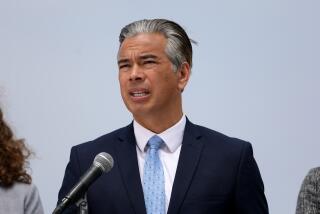Exxon to Pay Millions to Clean Up N.Y. Spill : Environment: Local officials are outraged by ‘mini-Alaska’ in waterway. Federal and state investigations continue.
NEW YORK — As a result of what is being called a “mini-Alaska,” Exxon Corp. will have to pay millions of dollars in cleanup costs for allowing a half-million gallons of fuel oil to spill from a pipeline into a busy waterway between New York and New Jersey.
The incident was the worst spill to hit the New York metropolitan area in two decades, and as the cleanup continues almost two weeks later, the stench of fuel oil still lingers in the area. Many local officials have expressed outrage because Exxon employees apparently disregarded repeated warnings from their own alarm system and allowed the leak to continue for 12 hours before acknowledging it.
Lawyers for the state of New Jersey filed suit against Exxon Friday. At the same time, New York officials hammered out an agreement with Exxon under which the oil giant agreed to compensate the state for the environmental damage caused by the Jan. 2 spill as well as the costs of a study to determine the extent of the damage.
Both states are continuing criminal investigations to determine whether Exxon was negligent or failed to act decisively enough to bring the spill under control.
The federal Environmental Protection Agency is also looking into the incident and has given Exxon until Wednesday to reply to a list of questions about its behavior.
The spill has brought a new round of unwelcome attention to Exxon, which is struggling to repair its image after one of its tankers spilled 11 million gallons of oil in Alaska last spring.
The heavily industrial Arthur Kill, where the spill occurred, is far from being as pristine as Alaska’s Prince William Sound. However, it is the site of an important and fragile wildlife sanctuary.
Prall’s Island, one of the areas affected by the spill off Staten Island, is a seasonal home to more than 1,000 pairs of rare herons.
Already, the bodies of more than 300 dead birds--mostly ducks, geese and gulls--have been recovered. Environmentalists fear the effects may worsen this spring, when migratory birds such as the herons return and begin feeding and nesting in the tainted areas.
Initially, Exxon estimated that only 5,000 gallons had spilled on Jan. 2, but it now acknowledges that at least 100 times that much fuel oil escaped through a rupture in the 20-year-old, 12-inch-wide pipeline. The cause of the leak has not been determined.
In its own version of events, Exxon has said that an alarm sounded in its leak-detection system late on the night of Jan. 1. Its operators, accustomed to false alarms from a system that had been operating poorly for years, relied on a backup procedure that indicated all was well.
That sequence of events happened two more times during the next 12 hours. Only after inquiries from the Coast Guard and local authorities did Exxon discover the leak and report it to federal and local officials.
“It has become clear that Exxon’s failure to properly maintain and monitor its leak-detection system has led to one of the greatest avoidable ecological disasters in New York City’s history,” New York Atty. Gen. Robert Abrams wrote Wednesday in a letter to Exxon President Lee R. Raymond. Drawing a comparison that many other officials here have made, Abrams called the situation a “mini-Alaska.”
After meeting with company officials Friday afternoon, Abrams said he is satisfied with Exxon’s assurances that it will pay for all the damage it has caused. State officials said those costs alone will run well into millions of dollars.
Abrams noted that New York retains the option of a lawsuit if Exxon fails to live up to its side of the bargain.
He said no estimates of the amount Exxon might owe would be available until after the study was completed. He added Exxon would not perform the study but would assume the cost.
New Jersey’s civil suit, filed by Atty. Gen. Peter Perretti, charged Exxon violated the state’s oil spill and water pollution control laws. The suit also charges damages under the common law.
Under New Jersey’s suit, Exxon is liable for fines of $50,000 daily for each violation, the number of which has yet to be determined, according to a spokesman for Perretti.
The suit also seeks to have Exxon repay any cleanup expenses the state incurs.
John Hagerty, a spokesman for the New Jersey Department of Environmental Protection, said the state hasn’t “been able to put a price tag on our environment yet.”
More to Read
Sign up for Essential California
The most important California stories and recommendations in your inbox every morning.
You may occasionally receive promotional content from the Los Angeles Times.










